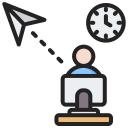Time Management Tips for Remote Employees
Chosen theme: Time Management Tips for Remote Employees. Welcome to a friendly space where practical strategies, relatable stories, and research-backed insights help you reclaim your time, focus your energy, and enjoy a calmer, more productive remote workday.
Designing Your Ideal Remote Workday
Start by anchoring your morning with three non-negotiables: hydration, five minutes of planning, and light movement. A developer I coached swapped frantic inbox checks for a quiet coffee and a handwritten priority list, and within two weeks reported calmer starts and fewer afternoon crashes.
Create focused blocks for deep work, collaboration, and admin, then buffer each with ten minutes for context switching. Parkinson’s Law warns work expands to fill time; fight it by sizing blocks intentionally. If surprises happen, slide the entire block, not the tasks inside it, to preserve momentum.
Not all breaks are equal. Replace doom scrolling with micro-walks, stretching, or sunlight on your balcony. One remote marketer sets a timer every ninety minutes to water a plant, breathe, and reset her shoulders; she claims this tiny ritual stopped her 3 p.m. productivity cliff.
Most Important Tasks Before Noon
Protect your prime brain hours for two Most Important Tasks. A remote analyst I met shipped a critical dashboard by doing thirty minutes daily before Slack, then expanded to ninety minutes as momentum grew. By Friday, the work that mattered most was already complete.
Saying No Without Burning Bridges
Decline gracefully using a yes-if approach: “I can take this after the release Friday, or we can drop X to make space.” Framing trade-offs invites partnership. Your time is finite; naming constraints turns you from blocker into responsible steward of team outcomes.
Weekly Review to Reset and Realign
Every Friday, scan your goals, calendar, and task list. Close loops, capture loose ideas, and schedule MITs for next week. This ritual reduces Sunday dread and ensures your plan reflects reality. Share your review checklist; we’ll feature creative approaches in future posts.

Tools and Systems That Carry the Load
Marry a digital calendar with a single task manager. Calendar holds time blocks; tasks hold the steps. Link tasks to events so work has a visible home. This reduces decision fatigue each morning and prevents invisible to-dos from hijacking your schedule.
Tools and Systems That Carry the Load
Turn repeatable tasks into templates: weekly report, sprint planning, stakeholder update. Automate reminders and pre-fill checklists to lower friction. An operations lead cut a two-hour report to thirty minutes by templating sections and auto-pulling metrics from a dashboard, freeing time for analysis.
Defeating Distractions at Home
Use site blockers during focus blocks, pin only essential tabs, and move social apps off your home screen. Silence non-critical notifications. A copywriter cut context switching by eighty percent by batching communication checks at set times, then closing Slack completely during deep work.
Defeating Distractions at Home
Agree on signals with family or roommates: a closed door, headphones, or a desk light means “do not disturb.” Post your focus schedule on the fridge. Calm, respectful clarity reduces resentment and interruptions, turning your home into a cooperative workspace rather than a battlefield.

Experiment with 25/5 Pomodoro cycles, 50/10 sprints, or 90-minute ultradian rhythms. Track which cadence matches your energy and task type. Short, intense bursts plus intentional breaks reduce attention residue and keep motivation high, especially when tackling demanding, ambiguous work from home.
Deep Work, Focus, and Attention


Collaborating Across Time Zones Without Chaos
Replace vague status chatter with concise, outcome-focused summaries: what changed, what it means, and what’s next. Tag owners and deadlines. This aligns expectations quickly across time zones and reduces the temptation to schedule yet another meeting to “sync.”
Collaborating Across Time Zones Without Chaos
Package handoffs with a checklist, links, and a quick Loom walkthrough. The recipient starts faster, asks fewer questions, and avoids rework. A distributed team cut cycle time by a day simply by standardizing handoff bundles for every cross-team dependency.


Sustainable Productivity and Wellbeing
Guard seven to nine hours of sleep, get morning light to anchor your circadian rhythm, and sprinkle movement snacks throughout the day. These fundamentals stabilize mood and sharpen focus, making every time strategy you try significantly more effective and reliable.
Sustainable Productivity and Wellbeing
Insert tiny resets between contexts: a glass of water, box breathing, or a short stretch sequence. These rituals discharge stress and clear mental residue. A support lead reported fewer mistakes after adopting a two-minute reset before entering complex, customer-facing conversations.
